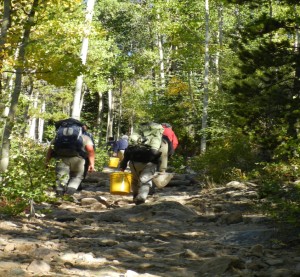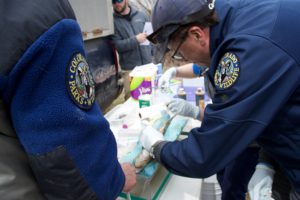By Brian Hodge In Trout Unlimited’s work with ranchers and farmers of the Upper Colorado River Basin, we often hear arguments about the relative benefits of flood and sprinkler irrigation for stream flows and fish.
Proponents of flood irrigation note that it requires a producer to divert more water from a stream than the crop can consume, and that unused irrigation water provides a benefit to fish because it returns to the stream when flows are otherwise low.
Meanwhile, proponents of sprinkler irrigation note that it requires a producer to divert little more from a stream than the crop demands, and that water left instream provides a benefit to fish because it maintains flows when water would otherwise be diverted.
But which is correct—in other words, does flood or sprinkler irrigation provide a greater benefit to fish in the Upper Colorado River Basin?
The short answer is, it depends.
In some cases, return flows from flood irrigation provide delayed benefits to streams and fish. A research group from the University of Wyoming recently concluded, for example, that late-summer return flows from flood irrigation are critical to the brown trout fishery in the New Fork of the Green River (Blevins et al. 2016). Moreover, the authors posited that if ranchers in the watershed improve efficiency by converting from flood to sprinkler irrigation, late-season streams flows will drop, and with them, the density (pounds/mile) of brown trout. The authors also suggested that perpetuating flood irrigation in the Upper Green River Basin might be an effective way to maintain its healthy trout streams.
Although flood irrigation return flow can provide delayed benefits to fish, not all return flows reach streams at a time and in an amount necessary to confer a benefit. An important assumption in the New Fork study was that water diverted in early-summer returned to streams later that season. Our own analyses suggest that lag time on the western slope of Colorado can range from as little as days or weeks to as much as months or more. Lag time on surface return flow (e.g., water flowing across a saturated field) is typically very short, whereas lag time on sub-surface return flow is highly variable and largely dependent upon the groundwater flow rate and distance between field and stream. In some cases, return flows are intercepted and used by other irrigators.
In our thinking, fish- and flow-related benefits are intimately tied and dependent on a number of variables. A 25% boost to flows in August, for instance, when flows are typically low and temperatures warm, could be quite meaningful for fish. In contrast, a 5% increase in discharge in mid-fall or early-spring, when flows are low to moderate and temperatures cool but not cold, could go undetected by fish. In short, the fish-related benefits of return flow (or lack thereof) depend on a number of factors, including the timing and amount of return flow, stream conditions, and the biology of the fishes in the stream.
Irrigation efficiency improvements, such as conversions from flood to sprinkler irrigation, can provide fish-related benefits where the short-term effects of leaving water instream outweigh the long-term benefits of taking it out. Consider an example where the current regime is flood irrigation and the lag time on return flows is on the order of days or weeks. In this case, there is little if any delayed benefit: water leaves from and returns to the stream in relatively short order. In the meantime, more water is diverted from the stream than is required to meet crop demand, and consequently, stream flows and fish habitat are reduced between the point of diversion and point of return. Also, return flow water—especially that on the surface—is likely to be warmer and more nutrient-rich than the source stream. Here, a simple efficiency improvement could improve flows and water quality below the point of diversion.
Because each agricultural operation and watershed is different, TU tends to avoid generalizations about flood and sprinkler irrigation. The truth is, fish-related goals might be attained with flood irrigation in one watershed, and with center pivot sprinklers in another. At the end of the day, the best solution is the one that works for both agricultural producers and fish.
Brian Hodge is a fisheries biologist and restoration coordinator for Trout Unlimited in the Upper Colorado River Basin.






 More than a century ago, John Muir extolled the virtues of wild nature as a place of renewal for city folk: “Thousands of tired, nerve-shaken, over-civilized people are beginning to find out that going to the mountains is going home; that wildness is a necessity; and that mountain parks and reservations are useful not only as fountains of timber and irrigating rivers, but as fountains of life.”
More than a century ago, John Muir extolled the virtues of wild nature as a place of renewal for city folk: “Thousands of tired, nerve-shaken, over-civilized people are beginning to find out that going to the mountains is going home; that wildness is a necessity; and that mountain parks and reservations are useful not only as fountains of timber and irrigating rivers, but as fountains of life.”
 opposed to the Superfund program, now supports the listing along with local communities and law makers. “I’m hopeful that with this designation the EPA will continue to collaborate with local, tribal and state officials and work to protect the local economy, maximizing local employment opportunities where possible, and providing adequate funding to ensure the cleanup begins as quickly as possible,” said US Rep. Scott Tipton.
opposed to the Superfund program, now supports the listing along with local communities and law makers. “I’m hopeful that with this designation the EPA will continue to collaborate with local, tribal and state officials and work to protect the local economy, maximizing local employment opportunities where possible, and providing adequate funding to ensure the cleanup begins as quickly as possible,” said US Rep. Scott Tipton.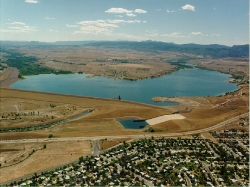 It was
It was  Projects like Stream Explorers have also helped the South Platte by teaching students about the river and how it is used for both human and aquatic needs. Learning how a city can impact the health of a river and how the river plays such a vital role to our way of life is important to teach to the next generation of river stewards.
Projects like Stream Explorers have also helped the South Platte by teaching students about the river and how it is used for both human and aquatic needs. Learning how a city can impact the health of a river and how the river plays such a vital role to our way of life is important to teach to the next generation of river stewards. Colorado Trout Unlimited, it's chapters, and volunteers helped Colorado Parks and Wildlife clip fins of Cutbow Trout as part of CPW's ongoing study of diploid vs triploid trout in Eleven Mile Reservoir.
Volunteers, along with staff from CPW helped clip over 26,000 fish in just the first day at the Mt. Shavano Fish Hatchery in Salida. Over the last two years, 97 volunteers helped clip over 148,00 fish in a six day period.
Colorado Trout Unlimited, it's chapters, and volunteers helped Colorado Parks and Wildlife clip fins of Cutbow Trout as part of CPW's ongoing study of diploid vs triploid trout in Eleven Mile Reservoir.
Volunteers, along with staff from CPW helped clip over 26,000 fish in just the first day at the Mt. Shavano Fish Hatchery in Salida. Over the last two years, 97 volunteers helped clip over 148,00 fish in a six day period. The fish used in this study are Rainbow X Cutthroat hybrid trout. Or commonly known as Cutbow trout.
The fish used in this study are Rainbow X Cutthroat hybrid trout. Or commonly known as Cutbow trout.
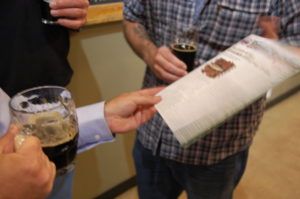
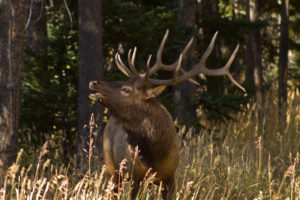
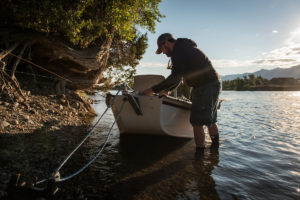 It is believed that the parasite causing the fish kill was introduced to the river by people and FWP along with Montana TU and its chapters are urging people to keep their gear cleaned. "Now that the parasite (Tetracapsuloides bryosalmonae) is in the Yellowstone and infecting fish, the main priority is eliminating additional stressors on those fish and preventing it from spreading to other rivers," said David Brooks,
It is believed that the parasite causing the fish kill was introduced to the river by people and FWP along with Montana TU and its chapters are urging people to keep their gear cleaned. "Now that the parasite (Tetracapsuloides bryosalmonae) is in the Yellowstone and infecting fish, the main priority is eliminating additional stressors on those fish and preventing it from spreading to other rivers," said David Brooks, 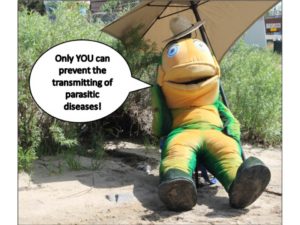
 The Western Native Trout Initiative (WNTI) has granted Colorado Trout Unlimited and the Cheyanne Mountain Chapter of Trout Unlimited $6000. Two $3,000 grants will be used to help bring public awareness to native trout and help further greenback genetic studies at Mt. Shavano Fish Hatchery. Western Native Trout Initiative is an organization dedicated to protecting native trout. They offer many different grant opportunities that provide conservation organizations with a means to realize their native trout projects.
The Western Native Trout Initiative (WNTI) has granted Colorado Trout Unlimited and the Cheyanne Mountain Chapter of Trout Unlimited $6000. Two $3,000 grants will be used to help bring public awareness to native trout and help further greenback genetic studies at Mt. Shavano Fish Hatchery. Western Native Trout Initiative is an organization dedicated to protecting native trout. They offer many different grant opportunities that provide conservation organizations with a means to realize their native trout projects.